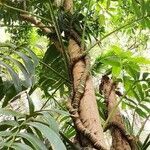Lianas, very large, to 20 m or more, very robust. Stem green at back, yellow at front, robust, 3-5 cm in diam., rooting, internodes 1-2 cm. Leaves scattered, each foliage leaf separated from next by several (up to 7) cataphyll-bearing nodes; petiole green, cylindric, 20-40 cm, shallowly canaliculate; pulvinus indistinct; petiolar sheath extending to ca. 2/3 along petiole; juvenile leaf blade orbicular, ca. 16 × 13 cm, margin entire, apex abruptly acute; mature leaf blade pale green abaxially, green adaxially, oblong-ovate, ovate in outline, 60-70[-100] × 40-50 cm, base subcordate, margin irregularly and asymmetrically pinnately divided, apex acute; pinnae 9-15 per side, ca. 20 × 3-5 cm at mid-leaf, base narrowed, apex truncate with ascending falcate tip, with a strong costa. Inflorescences axillary, solitary; peduncle green, cylindric, very robust, 11-20 × 1.5-3 cm. Spathe initially involute, afterward spreading, yellow on both sides, cymbiform, oblong-ovate, 17-20 × 10-12 cm. Spadix sessile, gray-green, cylindric, 15-16 × 2-3 cm, base oblique. Filaments flat, ca. 5 mm, nearly as long as ovary, base angustate; anthers yellow, oblong, less than 1 mm. Ovary hexagonal-conic, ca. 5 × 3 mm; style distinct, ca. 1 cm; stigma yellow, longitudinally oblong; ovules many; funicle laterally inserted, slender. Infructescence 15-20 × 5-5.5 cm. Berry green-white, base white or yellow, hexagonal-obconic, ca. 18 × 5 mm, apex with a persistent style, stylar region green-white, sloughing to reveal white or yellow pulp cavity. Fl. May-Aug, fr. mature next Jul-Sep.
More
A creeper. It is robust and grows 20 m long. The stems are yellow at the front and green at the back. They are 3-5 cm across and form roots at the nodes. The leaves are scattered. The leaf stalk is green and 20-40 cm long. It has a shallow canal along it. The leaves are round to oval and 16 cm long by 13 cm wide. They are pale green underneath.

